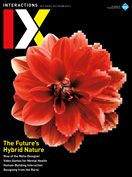Authors:
Simone Barbosa, Gilbert Cockton
This issue discusses the design of our futures and dives deeper into our community's concerns with inclusion and respect for the diversity of all human beings. In Community Square, Masitah Ghazali et al. introduce us to myHCI-UX, the Kuala Lumpur ACM SIGCHI chapter, and its growth strategies through collaboration with different communities both inside and outside Malaysia. Katta Spiel et al. explore how to deal with the complexity of our research participants' genders when designing surveys. Demo Hour project TypeCase illustrates how we can make a smartphone more inclusive. Nia Easley's project-turned-installation takes a look at a forgotten African-American enclave of Chicago and asks a poignant question: How can design be used to elucidate some of the more painful injustices of our time? Max Birk et al. discuss the opportunities and challenges of designing video games for mental health and well-being, while Susanne Lindberg uncovers the complexity of designing for and with people diagnosed with schizophrenia, including reducing stigma and risk of harm. Dag Svanæs's reading list explores designing for the body and with the body in mind, and also reminds us that we may benefit from getting lost sometimes. Uday Gajendar discusses the challenges of meta-design, going beyond checklists and individual talent toward designing the sustained conditions for good design. As education is key, Miriam Ferreira et al. report on an experience of bringing UI design and development to middle schools in Brazil, in a project where students learn how to design and develop mobile apps.
In the cover story, Verena Fuchsberger asks us to adopt a synergic view of digital-physical hybridity when envisioning the future, which we explore through our Demo Hour projects: The Carolan Guitar can tell us its own history; the VR Playground amplifies our swing-riding experience; and BRIAN brings a game-like feel to barbell exercises. In How Was It Made, Joran van der Sluis and colleagues reveal how the Penpal device was made to blend the digital and physical in sending and receiving letters, evoking good nostalgia.
Zooming out from the user and the artifact to the spaces we inhabit, Hamed S. Alavi et al. propose a research program on human-building interaction, integrating HCI, urban design, and policymaking. Jean Hardy et al. shed light on the various technological needs of rural areas, which are often overlooked by the HCI community. Jonathan Lazar et al. work toward a set of guidelines for kiosk accessibility and consider their various uses, such as public transit, government offices, healthcare, and voting. Juan Pablo Hourcade also urges us to consider large-scale societal needs, pondering the potential sinister repercussions of surveillance tools and prompting us to safeguard our individual freedoms and civil rights, while avoiding paternalism and dubious ethics. Simon Robinson et al. describe the opening day of a new lab, Swansea's Computational Foundry, where they embrace the current technological and ethical challenges of our society, exploring the continua of past and future, local and global. Rebekah Rousi waves her magic wand to propose a shift in human-robot interaction design—away from the robots' characteristics to the potential social effects they can have on us and our responsibility in designing them for harmony over functionality. And Antti Oulasvirta reminds us that HCI models have an important role to play in HCI design, particularly now that we have learned how to use models to drive the algorithmic generation and adaptation of UIs. In EXIT, David A. Shamma provokes us with a smartwatch's warning to (mis)trust other devices.
As artificial intelligence makes its way into everyday technologies, Wei Xu proposes to integrate ethically aligned design, technology, and human factors into a framework for human-centered, useful, and usable AI, and Allison Woodruff discusses 10 points about algorithmic fairness that we should all know when embarking in research and practice on HCI for AI.
This issue marks Susan Dray and David Siegel's last contribution as editors of the UX forum, after being part of the Interactions team for two dozen years. We wholeheartedly thank them for their dedication and excellent contributions to the magazine.
Simone Barbosa and Gilbert Cockton
[email protected]
Copyright held by authors
The Digital Library is published by the Association for Computing Machinery. Copyright © 2019 ACM, Inc.








Post Comment
No Comments Found